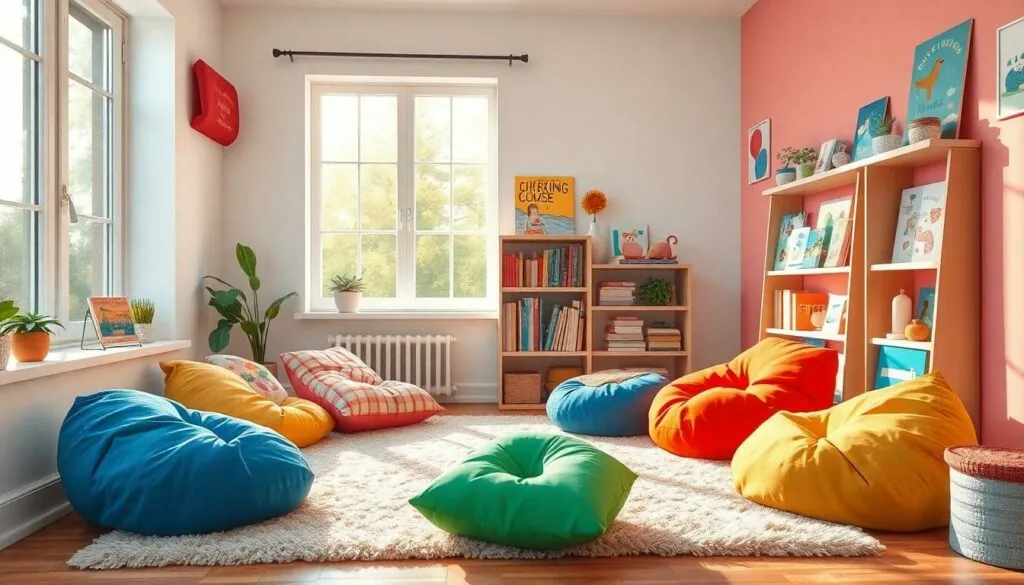Table of Contents
ToggleCreating a kids reading area isn’t just about stacking books and adding a few cushions. It’s about crafting a magical space where imaginations soar and adventures unfold. Picture this: a cozy nook filled with vibrant colors, comfy bean bags, and books that transport young readers to far-off lands. Who wouldn’t want to dive into a world of dragons, superheroes, and talking animals?
But let’s face it, getting kids to read can sometimes feel like herding cats. That’s where a well-designed reading area comes in. It’s not just a corner; it’s a sanctuary that invites curiosity and encourages exploration. With the right setup, kids won’t just read—they’ll be begging for more storytime, and parents will love it. Transforming a simple space into a reading haven might just be the best decision ever made for their little ones.
Importance Of A Kids Reading Area
Creating a dedicated reading area significantly enhances children’s engagement with books. A well-designed nook cultivates an environment that promotes a lifelong love for reading.
Cognitive Development Benefits
Reading areas encourage cognitive development in numerous ways. They foster improved literacy skills, enhancing vocabulary and comprehension. Each session spent immersed in a book stimulates imagination and critical thinking abilities. Children develop attention spans and focus through consistent reading habits. Quiet corners filled with books invite exploration of different genres, exposing kids to diverse cultures and ideas. Accessing various reading materials supports academic success in multiple subjects.
Emotional Well-Being Benefits
Reading spaces contribute positively to emotional well-being. They offer a safe haven for kids, allowing them to unwind and experience relaxation. Each visit to a reading nook can inspire creativity and self-expression through storytelling. Immersing in fictional worlds helps children navigate their own feelings, fostering empathy and understanding. Engaging with stories nurtures social skills and builds connections to peers and family. A tranquil reading area encourages children to form healthy habits, promoting mental health over time.
Designing An Effective Kids Reading Area
Creating an engaging kids reading area combines thoughtful space design with the right furniture. An effective reading nook not only promotes literacy but also nurtures a sense of adventure.
Space Considerations
Consider location and size when designing a reading area. Select a quiet corner of the home, preferably away from distractions like televisions and noisy appliances. Aim for a space that allows for natural light, which enhances visibility and mood. Design a cozy nook that encourages exploration and comfort. It’s beneficial to use wall space for shelving to store books at eye level. Including rugs and cushions can foster a relaxing atmosphere while also providing comfort for extended reading sessions.
Furniture Selection
Choose furniture that promotes comfort and accessibility. Opt for low bookshelves that invite children to reach their favorite titles easily. Comfortable seating options, such as bean bags or small chairs, create welcoming spaces for cozy reading. Consider using multifunctional furniture, like storage benches, to help keep the area organized. Ensure that all furniture pieces are safe, durable, and age-appropriate to support active use. Select seating that encourages good posture to promote healthy reading habits over time.
Creating A Inviting Atmosphere
An inviting atmosphere in a kids’ reading area enhances engagement with books. This space should motivate children to explore stories and ignite their imagination.
Color Scheme and Decor
Bright colors and whimsical decorations create an engaging reading nook. Cool shades like blues and greens foster calmness, while warm tones like yellows and oranges inspire energy. Wall art featuring beloved characters or story themes adds personalization. Patterns on cushions or rugs encourage playfulness, enticing kids to spend time reading. Incorporating elements like nature scenes can help promote a connection with the outdoors, making the space visually appealing and stimulating.
Lighting and Comfort
Optimal lighting significantly impacts the reading experience. Natural light boosts mood and enhances focus, so positioning the reading area near a window maximizes this benefit. Adding soft, adjustable lighting fixtures provides necessary illumination for evening reading. Cozy seating, such as bean bags or small armchairs, ensures comfort during extended reading sessions. Using layered textiles, like blankets or soft pillows, creates a warm environment that enriches the reading experience, inviting kids to cozy up with their favorite books.
Recommended Reading Materials
Creating an engaging reading area involves selecting materials that cater to children’s interests and developmental stages. Appropriate choices can significantly enhance their reading experience.
Age-Appropriate Books
Books tailored to specific age groups capture children’s interest and enhance comprehension. For toddlers, consider board books featuring bright images and simple texts. Preschoolers benefit from picture books with relatable themes and engaging stories. Early readers enjoy easy-to-read chapter books that focus on friendship, adventure, or humor. For middle-grade readers, choosing novels with complex plots can promote critical thinking and maintain engagement. Selecting age-appropriate books ensures each child remains motivated and eager to explore new stories.
Diverse Genres and Formats
Incorporating various genres and formats encourages kids to expand their reading horizons. Fiction introduces imaginative worlds, while non-fiction provides educational insights. Graphic novels offer visual storytelling that captivates reluctant readers. Poetry can inspire creativity through its rhythmic language. Audiobooks serve as an alternative format, allowing kids to enjoy stories during car rides or while relaxing. Offering diverse reading materials fosters a love for literature and supports the development of varied reading skills.
Engaging Kids In The Reading Area
Creating an engaging reading area captures children’s attention and fosters their love for literature. Various approaches enhance their interest and encourage exploration.
Interactive Activities
Incorporating interactive activities bolsters engagement in the reading area. Storytime sessions with interactive elements, such as puppets or props, encourage participation and imagination. Book-themed scavenger hunts motivate kids to discover new titles, turning reading into an adventure. Craft projects related to favorite stories allow children to express creativity while reinforcing comprehension. Role-play based on characters from books fosters social skills and critical thinking. Engaging in collaborative storytelling lets kids contribute ideas, enhancing their narrative skills.
Incorporating Technology
Integrating technology into the reading area can modernize the experience. E-readers and tablets provide access to numerous digital books, catering to diverse interests. Educational apps promote interactive reading experiences and offer games that build literacy skills. Virtual book clubs facilitate discussions among peers, making reading a social activity. Audiobooks enhance comprehension and listening skills, particularly for reluctant readers. By incorporating technology, children connect with stories in new ways and maintain their enthusiasm for reading.
Conclusion
Creating a vibrant reading area for kids goes beyond mere aesthetics. It transforms reading into an engaging adventure that nurtures curiosity and creativity. A thoughtfully designed space can significantly impact a child’s literacy development and emotional well-being.
By incorporating comfortable seating and age-appropriate materials, parents can foster a love for reading that lasts a lifetime. Engaging activities and an inviting atmosphere not only motivate children to explore different genres but also enhance their social skills and critical thinking.
Ultimately, a dedicated reading nook becomes a cherished haven where children can embark on countless literary journeys, enriching their minds and hearts in the process.








